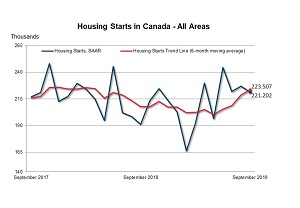 Wednesday, April 24, 2024
Wednesday, April 24, 2024  Wednesday, April 24, 2024
Wednesday, April 24, 2024 
OTTAWA, Oct. 8, 2019 /CNW/ – The trend in housing starts was 223,507 units in September 2019, compared to 218,782 units in August 2019, according to Canada Mortgage and Housing Corporation (CMHC). This trend measure is a six-month moving average of the monthly seasonally adjusted annual rates (SAAR) of housing starts.
“The national trend in housing starts increased in September,” said Bob Dugan, CMHC’s chief economist. “Higher trending single-detached starts in urban centres since July, following several months of declines combined with higher-trending multi-family units in September to push the total starts trend to its highest level since April 2018“.
Monthly Highlights
Vancouver
Vancouver Census Metropolitan (CMA) housing starts continued to trend higher in September. Compared to the same period last year, year-to-date single-detached home starts declined while the multi-units starts increased. In September, more than 85% of new construction was multi-units, most of which were in the City of Vancouver and the City of Port Moody. Overall, continuous strengthening of economic fundamentals supported a steady growth of 23% in the year-to-date starts in the CMA between 2018 and 2019.
Edmonton
Housing starts in Edmonton trended upwards for the fourth consecutive month in September. The year-over-year increase in total housing starts was largely driven by the multi-family market segment as levels more than doubled due to a rise in both rental and condominium starts. Despite elevated inventories, new housing construction has picked up, leading to an increase in year-to-date housing starts.
Saskatoon
Total housing starts in Saskatoon trended higher in September after construction on a number of condominium apartments got underway in the Brighton neighbourhood in the city’s east end. This supported a faster overall pace of multi-family construction, which offset a declining trend in single-detached starts during the month. Despite this increase in the six-month trend, total residential starts are down by 10% from January through September, compared to the same period in 2018.
Kingston
The trend in total housing starts in the Kingston CMA stood at a 29-year high this September. Both single-detached and multi-unit starts trended higher, with the strongest growth coming from condominium apartments. Year-to-date apartment starts are at a four-decade high.
Toronto
September total housing starts continued its upward trend in Toronto with all ground-oriented type home starts trending higher. The starts trends for semi-detached and townhomes were particularly strong, indicative of the popularity of these relatively affordable housing types among buyers looking for ground-oriented homes. Despite condominium apartment starts trending slightly lower in September, they continue to dominate housing construction across the Toronto CMA.
Ottawa
Ottawa housing starts trended up in September. Year-to-date activity is now up 11% over last year. Strong growth in apartment and row home construction offset declining single-detached starts. Rising single-detached home prices are pressuring affordability in both the new home and resale markets and skewing demand toward less expensive housing types.
Québec
From January to September, rental housing starts reached the highest year-to-date total for this period in at least 30 years. The growth in the supply of apartments was stimulated, in part, by the aging of the population. In addition to the many conventional rental housing projects started since the beginning of the year, in September, foundations were laid for over 700 units in seniors’ residences. Overall, the strength of the rental housing segment led to an increase of 29% in total housing starts in the Québec area since the beginning of 2019.
Trois-Rivières
In September 2019, housing starts continued their upward trend in the Trois-Rivières CMA. This rise was attributable to the renewed growth in single-detached housing starts and the increase in rental housing starts. The aging population and the low vacancy rate are stimulating rental housing starts.
New Brunswick
Total housing starts in New Brunswick increased in September compared to the same month last year. Multi-unit construction continues to dominate new home construction. The number of multi-unit starts this year is the highest on record for the January to September period. Sellers’ market conditions are contributing to the rebound in the single-detached market in major centres of the province. The September increase in single-family home construction was the second consecutive month of year-over-year growth. Year-to-date, total housing starts are 64% higher compared to 2018.
CMHC uses the trend measure as a complement to the monthly SAAR of housing starts to account for considerable swings in monthly estimates and obtain a more complete picture of Canada’s housing market. In some situations, analyzing only SAAR data can be misleading, as they are largely driven by the multi-unit segment of the market which can vary significantly from one month to the next.
The standalone monthly SAAR of housing starts for all areas in Canada was 221,202 units in September, down 2.5% from 226,871 units in August. The SAAR of urban starts decreased by 2.4% in September to 208,503 units. Multiple urban starts decreased slightly by 0.2% to 159,742 units in September while single-detached urban starts decreased by 9.2% to 48,761 units.
Rural starts were estimated at a seasonally adjusted annual rate of 12,699 units.
For more information, follow us on Twitter, YouTube, LinkedIn, Facebook and Instagram